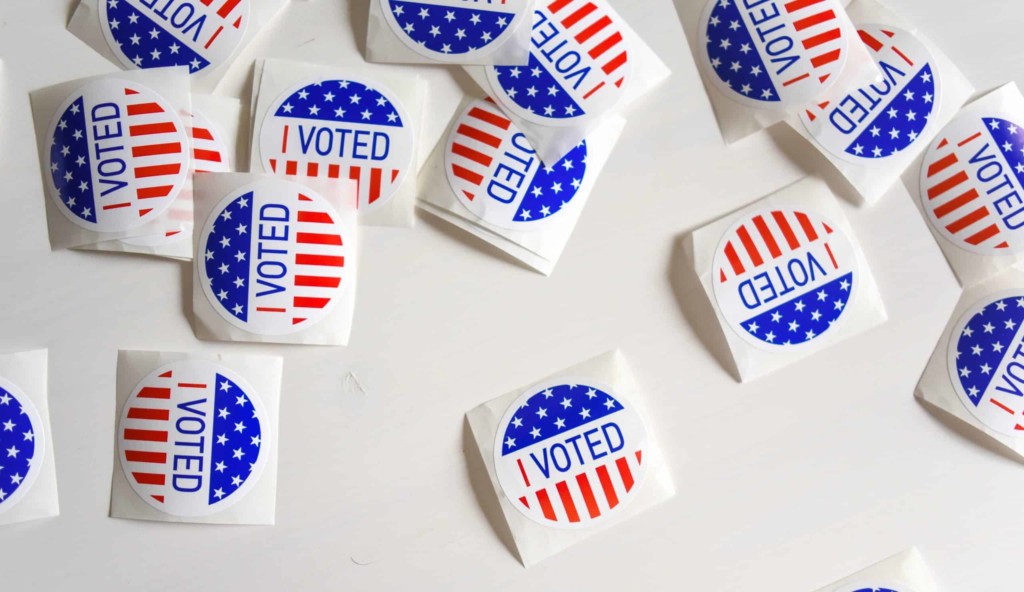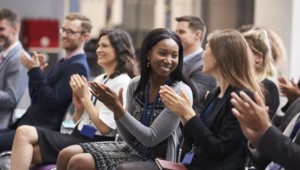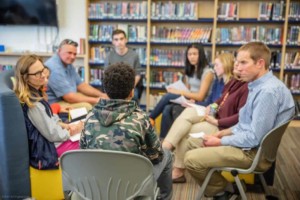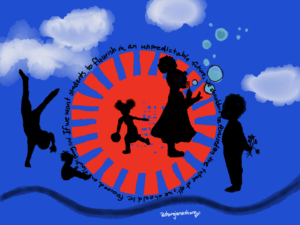Election 2020: Engaging Future Voters

Presidential elections are momentous occasions. In recent decades, the primary and general election cycles have captured the attention of the nation for many months. These events, the conversations surrounding them, and the consequences of them often define generational and collective milestones and set the social, economic, and political tone for many years to come. Presidential elections and the energy around the campaigns also often serve to catalyze increased engagement in social issues and participation in our democracy.
Though so much attention around elections centers on current, likely voters, presidential elections present an incredibly meaningful platform to connect future voters to our democratic processes using a real-world context and provide opportunities to model engaged, productive citizenry. Additionally, students of all ages are hearing the seemingly constant conversations about the election. They are seeing ads on television and social media. They are witness to the political debates at dinner tables and family gatherings. They are hungry for information and seek understanding of these topics.
Given the contentious nature of our current social-political context, exploring political issues and processes with students from a variety of backgrounds can seem daunting; debates around political candidates can be polarizing and contentious. These concerns may be heightened with the dialogue extending beyond the classroom walls directly into homes with so many students learning virtually.
However, civics education is a fundamental responsibility of public education and cannot be set aside despite the increasingly challenging circumstances. Students recognizing that they have the right to have a say in democratic outcomes and the responsibility to do so is fundamental to the health of our democracy. There are ways to structure this kind of learning that can focus the lessons on content rather than criticism and model civil and productive dialogue among people who may disagree. Focusing on election history, purpose, and process is both productive and important for developing students into engaged citizens.
As educators, we must share information, guide student exploration, and create a forum for open dialogue and questions. In short, in order to prepare our students as future voters and leaders, we must commit to using the current election cycle as an opportunity to educate, engage, and inspire our students so that future generations can reap the benefits of informed, engaged voters and leaders for years to come.
Understanding the Basics
The basic processes and channels for participation in a democracy often get lost in the dialogue and commentary around elections. But for students to understand how to be an active and engaged citizen and to understand the implications of these debates, they must first and foremost learn the basic foundations for participating in our democracy, the roles citizens play in that democracy, and how they exercise their rights and choices.
For young children, this begins with understanding the simple fundamentals involved in voting and group decision-making; that each person only gets to cast a single vote and that all must accept the decision of the majority, even if it is not the desired outcome. Beyond that, young students can understand that there are different ways to cast a ballot–including early voting, mail-in ballots, and in-person voting on election day. Older students are ready to understand more complex concepts like the structure of our government, including the different branches of government as well as the decision-making jurisdictions of local, state, and federal governments. Specific to voting, older students can begin to understand the role of the electoral college and how it relates to the popular vote.
Students of all ages can have valuable conversations about what it means to be both a good citizen and a good leader and how that relates to voting. Conversations around the qualities and characteristics of a good leader can be more productive than debating a specific candidate. Students can also understand the role citizens must play and why we each need to do our part by voting.
Learning About the History of the Right to Vote
Beyond the fundamentals, it is also important for students to learn about the history of voting in the United States. Conversations around the right to vote and how that right has been denied or withheld from certain populations are integral for students to understand the duty and privilege of participating in a democracy. Using history as a basis for these conversations provides more neutral ground.
Even elementary students can understand the inequities of certain groups of people–e.g., women or people of color–being denied the right to have their say in policy or electoral outcomes. Using biographical models and historical stories can be a great springboard for these conversations and a tool to inform understanding. This year’s 100th anniversary of women’s suffrage presents an opportune moment to highlight the courageous battles waged to change voter laws. And civil rights heroes like John Lewis, who spent his life fighting to expand the right to vote, can serve as great models for the power of collective action to make change. Older students are ready to learn about the implications of poll taxes, literacy tests, and gerrymandering as well as contemporary efforts to limit voter rights.
Exploring and Debating Contemporary Issues
Once students have an understanding of basic voting concepts and history, they have the foundation to begin exploring contemporary issues and current candidates. For young students, these conversations might include biographical overviews of the presidential and vice presidential candidates and some key differences in their backgrounds and approaches. For others, it might mean exploring a local city council or municipal issue. Students can come to understand the candidates as people, and the issues as opinions that groups of people hold. Even candidates’ personal characteristics like pets, children’s names, and where they grew up can personalize the candidates for children and help students to be able to identify current and future leaders.
For older students, this election presents an opportunity to engage in deeper learning about multi-dimensional, multi-perspective issues. They are ready to research different perspectives on key policy issues; understand the global, community, and individual impacts of those issues; and reflect on how their own beliefs align with different stances. In doing this, they can learn where to find accurate sources of information, practice evaluating biases, and how to work and collaborate with others who might disagree with them. In discovering that they agree and disagree with each candidate on specific issues, students learn that they must establish priorities to make the decision of what one person they will vote for in each office. Students can also begin to delve into the relationship between greater voter participation and how that impacts representation.
Practical Implementation
Teaching these concepts has become more challenging with virtual learning models and physical distancing protocols within schools. But there are still many meaningful ways to structure learning and conversations about these important topics.
Our youngest learners can best learn about voting through hands-on, active participation using topics that are meaningful to them. Teachers might invite students to vote on a class read-aloud book choice, the name of a classroom mascot or pet, or to choose between two celebratory activities such as a classroom dance party or a game of Simon Says. This voting process can be a powerful way to teach children that they have a voice in decision-making. It also allows for the lesson that sometimes their choice will align with the majority and sometimes it will not. Older elementary students might begin to learn more about the government and how the election process works. To learn more about the candidates and current issues, students and teachers can visit the Scholastic Classroom Magazine Election 2020 Coverage. They can take quizzes, play games, and even cast their vote in Scholastic’s mock election.
Middle school and high school students are able to research and think critically about key issues that will both inform and be affected by this election. Students might use a sample ballot to research and discuss the candidates and proposed amendments. This models how an engaged citizen approaches voting in an informed way. PBS Learning Media’s Election Collection provides videos, lesson plans, and resources for students in middle and high school as they grapple with these issues.
These older students are able to understand the nuances of the popular vote versus the electoral college. Using this electoral college map, they can imagine various scenarios that would lead to different outcomes. Analyzing different scenarios in the lead up to November 3rd will help them understand the process and outcomes as they unfold. To reinforce the power of a vote, students might analyze tallies and differences after the election results are final.
An Investment in our Democracy
Historically, the United States has much lower voter turnout rates than other developed countries. A 2018 report from Pew Research shows that the US ranked 26th of 32 highly developed countries. Far too many adults in the US today do not see themselves as having a meaningful or active role in the political process–by exercising their power through voting, by actively seeking out information on government decisions and their implications, or by participating in political conversations and debates to better understand and inform their thinking.
In order to invigorate our young people and change the course of civic discourse and engagement, we must cultivate ways to get students excited about participating in our democracy as a lifelong right and responsibility. We must use the election cycle to spark important conversations and empower our children as thinkers, problem-solvers, and contributors to our communities. To quote Larry Sabato, Professor of Political Science and Civic Engagement at the University of Virginia, “Every election is decided by the people that show up.” For elections to be representative, the people need to be ready and excited to show up once they reach the voting age. And that is what educators can assure by using this presidential election as an opportunity to empower future voters.
For more, see:
- Change Management at Harmony Public Schools: When Prior Innovations Become Status Quo
- Finding Your Entry Point to Mastery Learning
- New Arts Integration Efforts Address Healing-Centered Engagement, Transformative Agency
Stay in-the-know with innovations in learning by signing up for the weekly Smart Update.







0 Comments
Leave a Comment
Your email address will not be published. All fields are required.